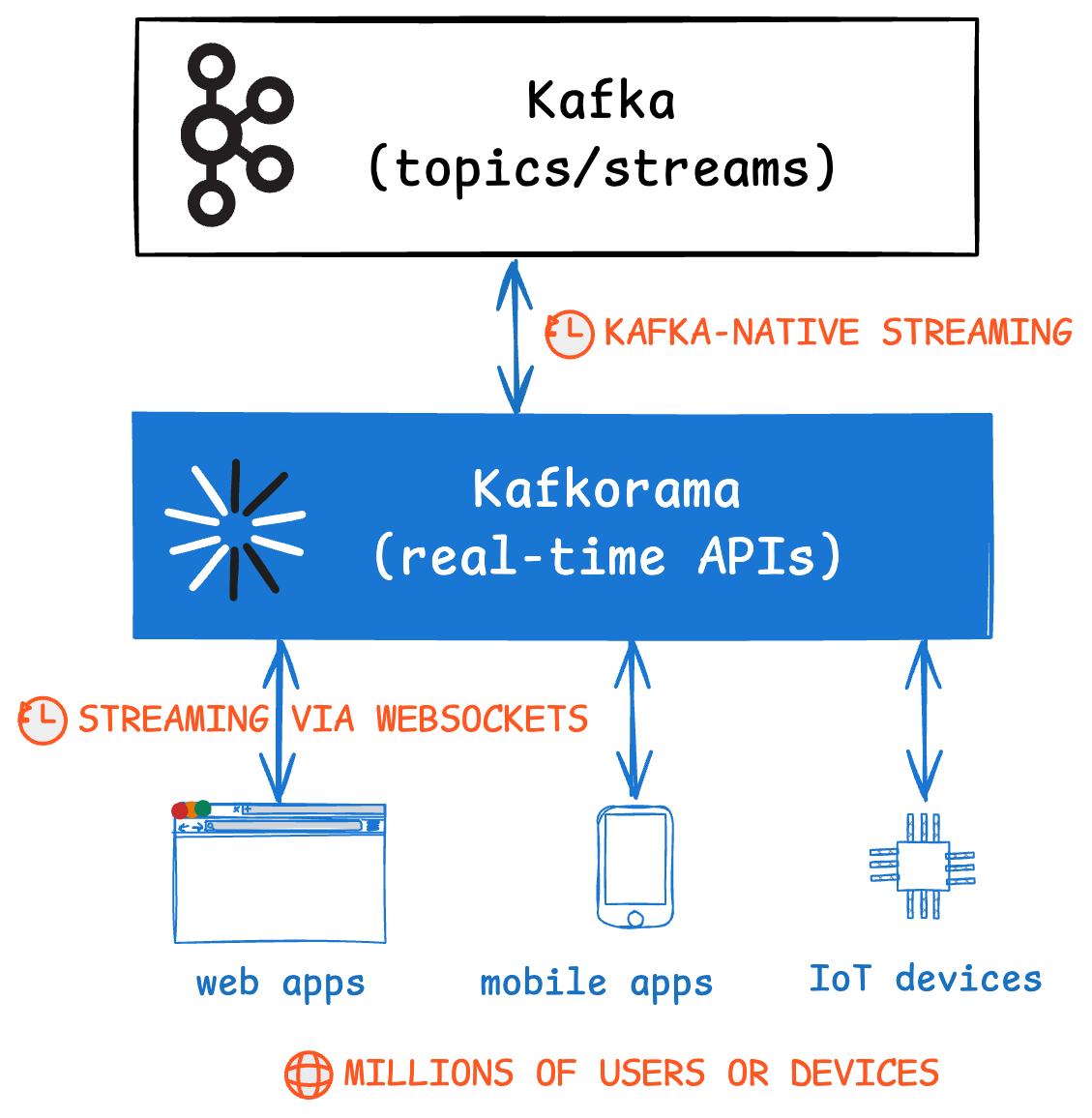Kafkorama turns Kafka streams into real-time APIs — easy to publish, discover, and integrate into real-time web, mobile, and IoT apps. Trusted to stream real-time data to and from hundreds of millions of users, it delivers unparalleled scalability.

Users served with real-time data
from a single node
Monthly users served with
real-time data in production
Years powering scalable
real-time data in production
SDKs to build real-time apps —
iOS, Android, Java, .NET, JS, and more
Turn Kafka streams into discoverable, pub/sub APIs — easily accessible through SDKs for the most popular platforms. Empower your teams, partners, and external developers to build real-time web, mobile, and IoT apps. Secure by design, with industry-standard JWT-based access control.
Benchmarked to stream real-time data to 10 million clients from a single node, Kafkorama Gateway offers unmatched vertical scalability. When deployed as a highly available cluster, its nodes operate independently and scale horizontally in a linear fashion — just add more nodes to serve more clients.
Run in the cloud or on-prem — on bare metal, VMs, or with Kubernetes/Terraform automation. Connect natively to any Kafka — Event Hubs, MSK, Confluent — without Kafka Connect or any changes to your Kafka setup.

REST and Streaming APIs may share endpoints and verbs (GET/POST vs.
SUBSCRIBE/PUBLISH), but their communication models differ. REST APIs use
a synchronous request-reply model, while Streaming APIs use an asynchronous pub/sub model. For
example, a sports app can deliver live scores via the endpoint /sports/scores/match using
either model.
Over a 90-minute match, each REST user makes around 180 API calls — compared to a single connection with a Streaming API. At scale — 1M users — that's 180 million REST API calls vs. just 1 million Streaming API connections. Less load, lower cost — especially with a Streaming API Management solution built to scale to millions.
REST updates can arrive with up to 30s delay due to polling intervals. Streaming APIs deliver updates in milliseconds via a persistent WebSocket connection — providing a truly real-time experience.
Just like REST APIs, Kafka topics can be abstracted and documented as streaming APIs. Kafkorama requires no configuration to map API endpoints to Kafka topics — each streaming API endpoint corresponds directly to a Kafka topic and (optionally) a Kafka key. Kafkorama Portal lets developers document these APIs using the AsyncAPI standard, providing consistent, shareable documentation. Developers can also generate JWT-based access keys and use the built-in console to interact with streaming APIs in real time.
Internal teams, partners, and external developers can browse, adopt, test, and use streaming APIs via the Kafkorama Portal — enabling faster prototyping and real-time app development, just like with REST developer portals.
The Kafkorama Gateway streams real-time APIs between Kafka and millions of clients — over WebSocket connections backed by a highly scalable, horizontally and vertically optimized engine. It supports real-time, bidirectional communication, enabling both data delivery from Kafka and event ingestion back to Kafka. Like a REST API gateway, it acts as the runtime layer — but purpose-built for real-time delivery at scale.

Kafkorama Portal transforms Kafka streams into Streaming APIs — using a minimalistic approach to API management through a lightweight portal. Define APIs using Kafka topics and keys, document them with AsyncAPI, secure them with JWT-based access keys, then discover, test, and generate integration code for web, mobile, or IoT in your preferred language.
We can show that a single instance of Kafkorama running on a single server can stream 1 Gbps of real-time data to 10 million concurrent clients — with under 100 milliseconds latency. But what really matters is how it performs in your environment, with your workloads. Start your no-risk evaluation and see how easily Kafkorama scales in your own environment.
Can’t find the answer you’re looking for? Reach out to our team — we’d be happy to help.